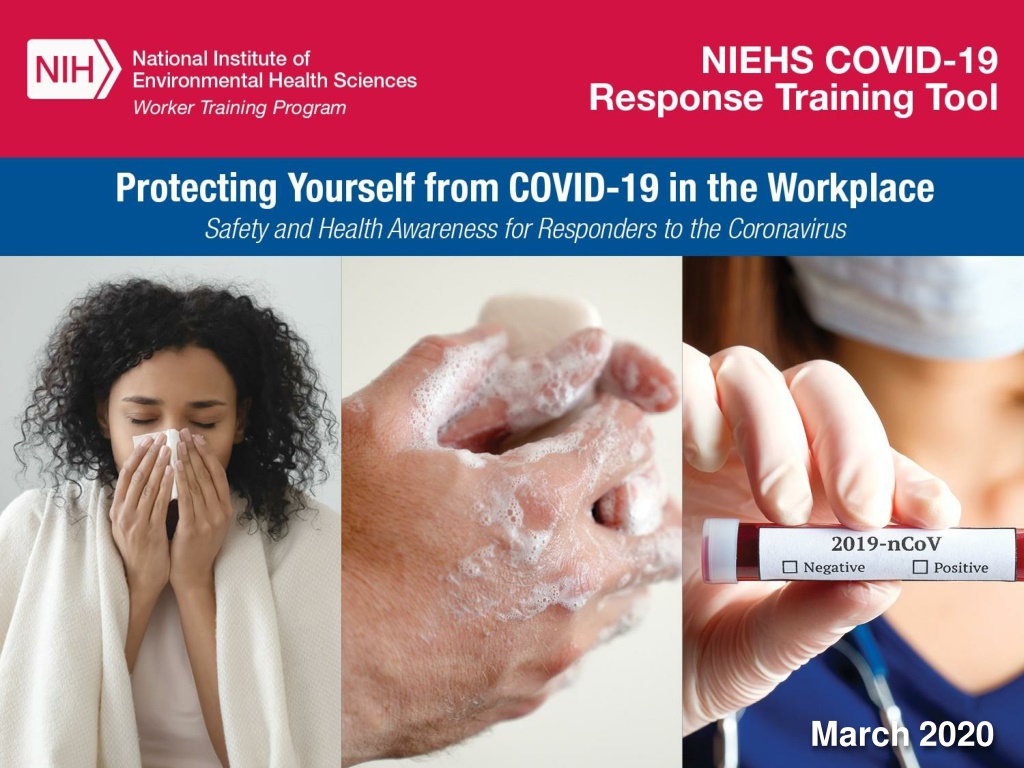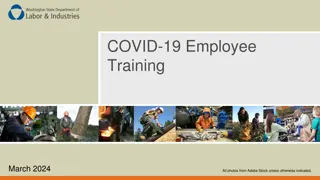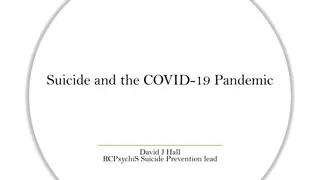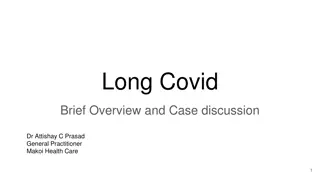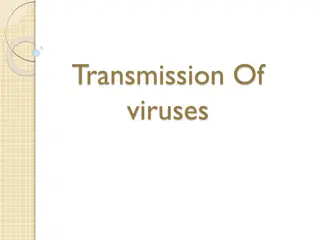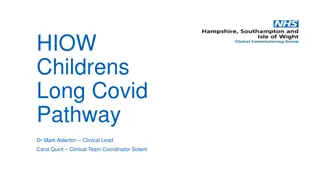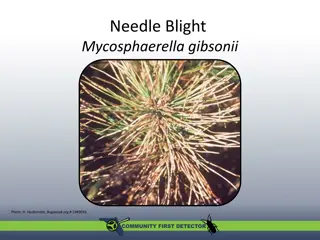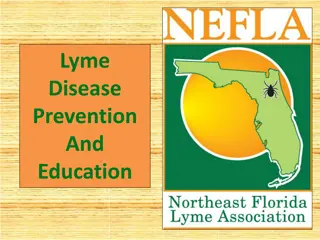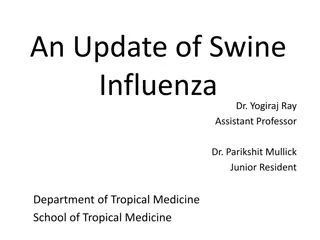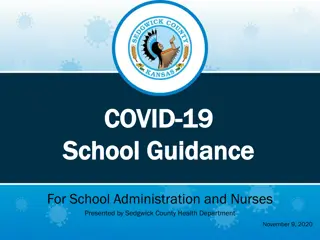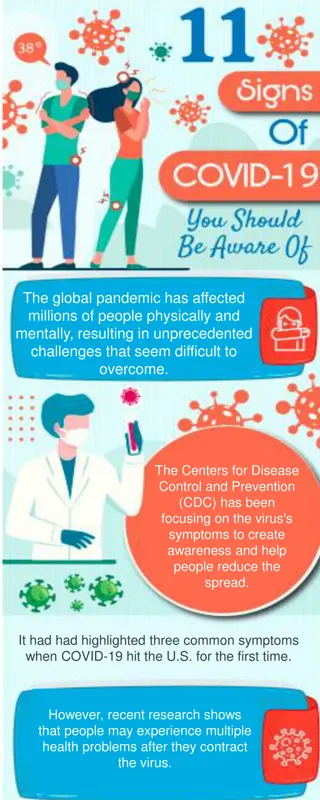Essential Information on COVID-19: Prevention, Symptoms, and Transmission
Individuals can protect themselves by staying informed, washing hands frequently, using hand sanitizer, and staying home when sick. Proper handwashing techniques, details on SARS-CoV-2 virus, transmission routes, incubation period, and common symptoms of COVID-19 are outlined in the content.
Download Presentation

Please find below an Image/Link to download the presentation.
The content on the website is provided AS IS for your information and personal use only. It may not be sold, licensed, or shared on other websites without obtaining consent from the author. Download presentation by click this link. If you encounter any issues during the download, it is possible that the publisher has removed the file from their server.
E N D
Presentation Transcript
What can individuals do? Be informed and prepared. Wash your hands frequently. Use alcohol-based hand sanitizer. Avoid touching your eyes, nose, and mouth with unwashed hands. Stay home when you are sick. Cough or sneeze into a tissue or yourelbow. Clean and disinfect frequently touched objects and surfacessuch as cell phones. Be prepared if your child s school, daycare facility, or your worksite is temporarily closed. 2
Five steps to proper handwashing Wet your hands with clean, running water(warm or cold), turn off the tap, and applysoap. Lather your hands by rubbing them together with the soap. Lather the backs of yourhands, between your fingers, and under yournails. Scrub your hands for at least 20 seconds.Need a timer? Hum the Happy Birthday song from beginning to end twice. Rinse your hands well under clean, running water. Dry your hands using a clean towel or airdry them. 3
What is SARS-CoV-2? SARS-CoV-2 is the virus that causes coronavirus disease 2019 (COVID-19) SARS = severe acute respiratory distress syndrome Spreads easily person-to-person particularly when someone sneezes Little if any immunity in humans Detailed information: https://www.cdc.gov/coronavirus/2019- ncov/index.html 4
Transmission COVID-19 is spread from person to person mainly through coughing, sneezing, and possibly talking, and breathing. Droplet - respiratory secretions from coughing or sneezing landing on mucosal surfaces (nose, mouth, and eyes) Aerosol - a solid particle or liquid droplet suspended in air Contact -Touching something with SARS-2 virus on it and then touching mouth, nose or eyes Other possible routes: Through fecal matter 5
Incubation period The incubation period is the time between exposure to a virus and the onset of symptoms. With COVID- 19 symptoms may show 2-14 days after exposure. People are most contagious when they are the most symptomatic. Scientific uncertainties: People who are infected may be contagious before they develop symptoms or even if they never develop symptoms. 6
COVID-19 can cause mild to severe symptoms Other symptoms may include: Most common symptoms include: Sore throat Runny or stuffy nose Body aches Headache Chills Fatigue Fever Cough Shortness of breath 7
Severe symptoms emergency warning signs for COVID-19 Most people will have mild symptoms and should recover at home and NOT go to the hospital or emergency room. Get medical attention immediately if you have: Difficulty breathing or shortness of breath. Persistent pain or pressure in the chest. New confusion or inability to arouse. Bluish lips or face. 8
There are two scenarios when a person might be suspected as having COVID-19: If they have had: A potential exposure within 14 days before the onset of symptoms. Symptoms, including cough, fever, and shortness of breath If they are experiencing: 9
Confirmed case A confirmed case is a suspect case with laboratory-confirmed diagnostic evidence of SARS CoV-2 virus infection. U.S. Centers for Disease Control and Prevention viaAP 10
How long does SARS-CoV-2 survive outside of the body? It is not clear yet how long the coronavirus can live on surfaces, but it seems to behave like other coronaviruses. Virus may persist on surfaces for a few hours or up to several days, depending on conditions and the type of surface. It is likely that it can be killed with simple disinfectant on the EPA registered list below. https://www.epa.gov/pesticide-registration/list-n-disinfectants- use-against-sars-cov-2 11
Increased risk of severe illness COVID-19 poses a greater risk for severe illness for people with underlying health conditions: Heart disease Lung disease such as asthma Diabetes Suppressed immune systems The elderly have higher rates of severe illness from COVID-19.Children and younger adults have had less severe illness and death. Because COVID-19 is new there are a lot of scientific unknowns such as the impact on pregnant women and theirfetuses. 12
Treatment and vaccines There is no vaccine to prevent COVID-19. There is no specific FDA approved medication or treatment for COVID-19. Treatment is supportive. People who are mildly ill with COVID-19 should isolate at home during their illness. 13
Basic hygiene and social distancing Stay home when sick. Wash hands or use sanitizer frequently and after coughing, sneezing, blowing nose, and using the restroom. Avoid touching your nose, mouth, & eyes. Cover coughs & sneezes with tissues or do it in your sleeve. Dispose of tissues in no-touch bins. Avoid close contact with coworkers and customers. Avoid shaking hands/wash hands after physical contact with others. Click here for more information on social distancing: https://www.cdc.gov/coronavirus/2019-ncov/prevent-getting-sick/social- distancing.html 14
Prevention in all work settings Wash hands after removing gloves or when soiled. Keep common surfaces such as telephones, keyboards clean. Avoid sharing equipment if possible. Minimize group meetings by using phone, email, and avoid close contact when meetings are necessary. Consider telework. Limit unnecessary visitors to the workplace. Maintain your physical and emotional health with rest, diet, exercise and relaxation. 15
Mental health & stress As the number of cases of COVID-19 increase, so does the associated anxiety and stress. Consider the following steps: Use your smart phone to stay connected to family and friends. Shift from texting to voice or video calling to feel more connected. Keep comfortable. Do more of the things you enjoy doing athome. Practice stress relief whenever you feel anxiety building do some deep breathing, exercise, read, dig in the garden, whatever works for you. Avoid unhealthy behavior such as excess drinking that will just increase your anxiety afterwards. Keep looking forward. Make some plans for six months down theroad. 16
REQUIRED: Training Receipt Please fill out and submit the form below to confirm that you have completed this training: bit.ly/GCFBC-19Training 17
For more information Centers for Disease Control and Prevention(CDC) http://www.cdc.gov Occupational Safety and Health Administration (OSHA) http://www.osha.gov World Health Organization http://www.who.int/en/ National Institute for Occupational Safety and Health(NIOSH) http://www.cdc.gov/NIOSH/ NIEHS Worker Training Program https://tools.niehs.nih.gov/wetp/index.cfm?id=2554 18
